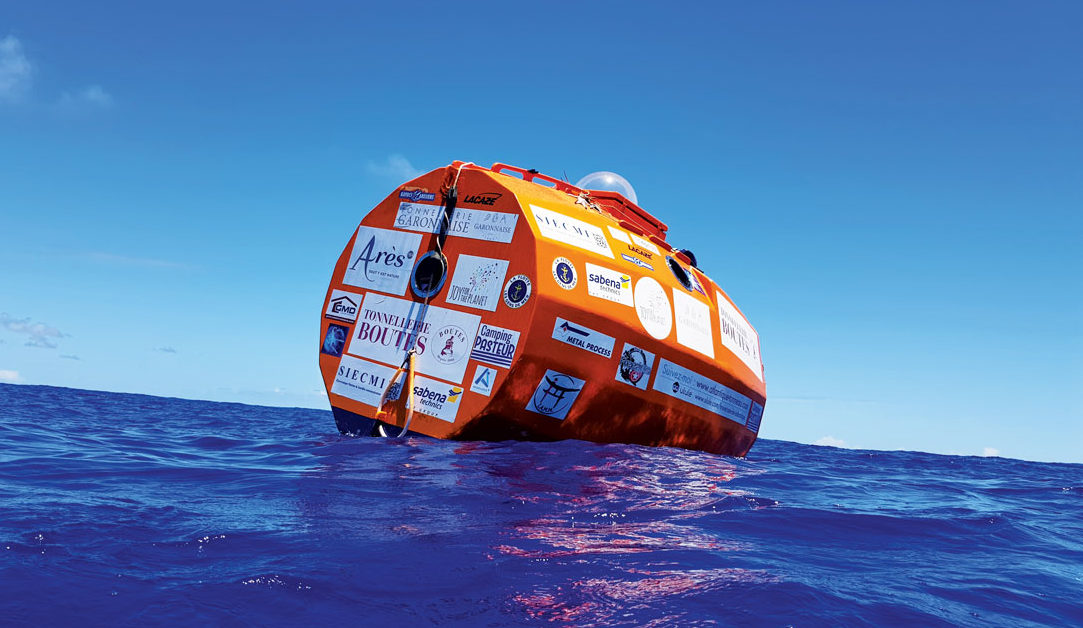Rowboats, tree trunk crafted rafts, papyrus reed-built sailboats, outboards and RIBs (rigid inflatable boat) are among the vessels that adventurous seafarers have employed in modern times to successfully cross the Atlantic Ocean. As of May, add a wooden barrel to this list. More specifically, on May 4, 72-year-old Frenchman Jean-Jacques Savin stepped ashore in St. Eustatius after leaving the Canary Islands on December 26, 2018. Savin traveled 3,125 nautical miles in 127 days in a 10-foot-long plywood-built barrel.
“I have cherished the sea since my early childhood,” says Savin, a former military paratrooper and park ranger in Africa. “When my daughter, Manon, was born we went sailing for 7 years.”
Savin, an experienced navigator, has crossed the Atlantic four times already aboard a conventional sailboat. He is also no stranger to extreme physical challenges. The Frenchman has swum across the Arcachon Bay on France’s Atlantic Coast, hiked Mont Blanc, the tallest mountain in the Alps at over 15,000 feet and swam, ran and biked his way to a second-place finish just two years ago in the French Triathlon Championships. However, the idea to use only wind and currents to cross the Atlantic in an engine-less, sail-less barrel came from an incredible 1950s tale. So, as the story goes, a young French doctor and biologist named Alain Bombard left the Canaries on a rubber raft bound for Barbados in conditions that simulated a shipwreck. Bombard’s success proved it was possible to survive on natural resources like fish to eat. Savin was captivated with the story and wanted to accomplish a similar feat in the 21st century. But first, there was a barrel to build.
Savin constructed the 10-foot long, 7-foot wide barrel, with only 65-square feet of living space inside, in a small shipyard in his native Ares, France. The outer layer of the safety orange painted barrel was made of a resin-coated plywood that he reinforced to protect against cracks by whale attacks and big waves. There are four portholes: one on each side, one under the hull, which was ideal for watching fish and other sea life, and one in the top hatch opening. The 24-inch hatch is protected by a clear bubble-like covering that protects against the elements while offering a peek out at the sea beyond. A weighted keel balanced the barrel. Inside, Savin outfitted the cozy interior with a small wood plank bed and opposite that a stove for cooking. Two 100W solar panels provided power so that he could connect to satellite and provide some 23,000 Facebook followers regular updates throughout his voyage. Safety equipment included a life jacket, lift raft, fire extinguisher and personal distress beacon. Last, but not least, Savin packed a block of foie gras and small bottle of wine to ring in the New Year and celebrate his 72nd birthday on January 14.
“The most exhilarating part of the trip was the refueling with food on the 85th day by the American oceanographic (NOAA) ship, the Ronald Brown. The most difficult moment was the close approach of a cargo vessel. I didn’t have a radio, so I sent up a smoke signal using a flare in order to be spotted. We missed each other by about 50 feet,” Savin explains.
Another moment that proved more harrowing than happy at first was Savin’s approach to St. Eustatius. There was a strong wind and he feared crashing on the reefs. The U.S. Coast Guard had him on their radar, literally and figuratively, in case he needed assistance. Ultimately, the nearby tanker, the Kelly Anne, rendezvoused with Savin, hoisted his barrel to the safety of their ship and took him aboard for a meal, shower and the final distance to dry land.
One of the first people to welcome Savin to the Caribbean was Ingrid Walther, one of the owners of the Scubaqua Dive Center in St. Eustatius.
“As soon as he touched land I just squeezed him in my arms and congratulated him,” says Walther. “It was really moving and he was so happy to speak French again. The tanker crew were only English-speaking, so he did not get a chance to share a lot with them as his English is very basic. We helped him with Customs and Immigration, found a free hotel room for him at the Old Gin House, welcomed him into our dive center to get Internet so he could let his friends in France know he was fine. We also invited him home for dinner to enjoy a Swiss cheese raclette, knowing he did not get a chance to have a proper meal during the past months.”
Walther adds, “Most people probably did not take Jean-Jacques seriously before his adventure, but he did it! I think we all need to meet people like him, who are simply different from most of us and live a passionate life far different from ours. They manage to reach a total freedom away from the society and its living rules!”
Savin traveled next to Martinique where he arranged for the barrel to be shipped on a cargo vessel back to France, where it will be on display in a number of exhibitions. He flew back home too in mid-May.
In September, Savin plans to publish a photo-illustrated book of his trip. For more information, visit: www.facebook.com/BOUTESA






